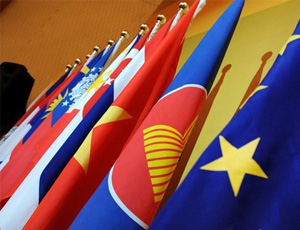ASEAN Summit in Brunei: AEC and the South China Sea

Apr. 26 – The leaders of the ASEAN countries converged in Brunei Darussalam this week for the 22nd summit of the regional grouping. On top of the agenda was further facilitation of the economic integration process that aims to unite the countries in the ASEAN Economic Community (AEC) by 2015. Furthermore, the summit also sought to foster deliberation on international issues of common concern, such as territorial disputes in the South China Sea and the negotiations for the Regional Comprehensive Economic Agreement.
“ASEAN has an ambitious agenda which it is in the process of fulfilling,” said Singaporean Prime Minister Lee Hsien Loong, applauding recent progress toward economic integration that he said would increase prosperity and reduce the likelihood of conflict in the region.
Nearly 80 percent of the AEC blueprint, a total of 259 different measures, has now been concluded in anticipation of its entry into force by December 2015. The AEC blueprint, which was adopted in 2007, is meant to facilitate the creation of a single market and production base, partly through the near elimination of inter-region import duties.
Analysts have pointed out, however, that some of the most difficult areas are yet to be addressed.
Prime Minister Lee said services liberalization and trade facilitation remain challenges, and he also noted the need for additional legislative and physical infrastructure inter-connecting the region. He remarked that increased integration is important for further rapid development.
“Unless ASEAN develops an effective economic community, a lot of the emphasis and focus of investors of the developed countries and the trading partners will be on China and Northeast Asia, South Korea and other parts of the world, and we will lose out,” he said.
Regional observers maintain that the AEC is a move in the right direction for ASEAN.
“The regional environment has changed. ASEAN should rightfully treat all the major economic powers equal handedly, welcome investments, regulate our markets, make it more competitive, by hosting the major investors whether it is the American, the Chinese, the Japanese; it can’t be a bad thing, it is only good for us… More than 10-15 years (after the 1997 financial crisis), ASEAN is ready and poised for higher growth. We must put our act together,” said Associate Professor Tan Khee Giap, Co-director of the Asia Competitiveness Institute.
While the continued progress on the AEC blueprint signaled development of ASEAN integration, the summit also resulted in an important announcement on a key inter-ASEAN initiative: The Regional Comprehensive Economic Partnership (RCEP). The chairmanship announced that negotiations would commence as early as next month.
The proposed RCEP would encompass the 10 ASEAN countries as well as the groups frequently referred to as the “inner three” (China, South Korea, and Japan) and the “outer three” (India, Australia, and New Zealand). With the goal of accommodating developing nations and reaching a deal quickly, this agreement is believed to have lower ambitions in terms of comprehensive integration than the Trans-Pacific Partnership Agreement (TPP) championed by the United States. Instead, the deal aims to merge various trade agreements already in place to maximize economic benefits.
Encompassing 3.3 billion people and about a third of the world economy, a successful deal is nevertheless projected to significantly bolster trade and investment. Analysts have also noted that the scope of the negotiations could expand as participants may wish to respond to “healthy competition” from the TPP, which is expected to be finalized this year.
The current territorial disputes in the South China Sea were also high on the agenda after last year’s summit failed to reach a common position, threatening ASEAN’s unity and credibility. Cambodia, a close ally of China, refused to have such territorial issues mentioned in a post-ministerial statement when it hosted the summit last year. This drew protests from Vietnam and the Philippines, and ultimately resulted in the lack of a post-summit communiqué for the first time in the history of ASEAN.
This time, the final statement iterated the group’s commitment to a number of frameworks. This includes the Declaration on the Conduct of Parties in the South China Sea (DOC) (which was signed by the ASEAN countries and China in 2002, pledging peaceful dispute resolution and increased cooperation in areas of mutual concern), ASEAN’s Six-Point Principles on the South China Sea (2012) and the Joint Statement on the 10th Anniversary of the DOC (2012).
Building on these commitments, ASEAN foreign ministers were tasked with continuing their work on developing a greater Code of Conduct in the South China Sea in cooperation with China. According to analysts, such a Code of Conduct would essentially be a non-aggression pact and is aimed at hindering the further deterioration of relations. China, however, has so far shown no intent to join such an agreement, preferring bilateral negotiation.
While disappointed that the meeting had not lead to more concrete outcomes within the South China Sea, Philippine President Benigio Aquino remained optimistic.
“So there is unity of purpose and one can always be hopeful that that will lead to something more concrete,” he said.
- Previous Article EU Removes Sanctions Against Myanmar
- Next Article ASEAN and Chinese Foreign Ministers to Meet Over South China Sea Claims








